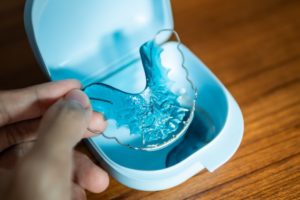
Did you wear braces or Invisalign earlier in life, but have found that your teeth have slowly become more crooked since then? Orthodontic treatments have the potential to straighten your smile for life, but that’s only if you wear your retainer as instructed afterwards. If you’ve neglected wearing your retainer, your teeth may gradually shift out of position once again! Now that they have, should you start wearing your old retainer again? The answer might surprise you! Read on as your Cleburne orthodontist explains what you should do next.
How Do Retainers Work?
Did you know that your jawbone deteriorates and reforms during an orthodontic treatment? It needs to change shape in order to accommodate the new positions of the roots of your teeth. Once you’ve worn your braces for the estimated amount of time or finished your last set of Invisalign aligners, it’s important that you wear a retainer regularly to make sure your teeth stay straight as the jawbone heals and strengthens underneath them. After that, you’ll likely need to wear a retainer occasionally for the rest of your life to keep your smile in shape as your mouth naturally changes shape with age.
What You Need to Know About Wearing an Old Retainer
At first, it may seem obvious that you need to start wearing your old, neglected retainer again if you notice your teeth are shifting out of place. However, there are times when this can do more harm than good! If your teeth have moved a substantial amount, wearing your retainer could put far too much pressure on them. This could damage the enamel, cause discomfort, and in the worst cases, could fracture your tooth roots by moving your teeth too quickly. Unfortunately, it’s not always easy to tell just how far out of alignment your teeth are just by looking at them. Thankfully, there are some things to keep in mind that can help you make the best decision.
How to Use an Old Retainer to Restraighten Teeth
Instead, to decide if you should wear your old retainer again, think about how long it’s been. The length of time since the last time you wore your retainer can be a good measuring device to estimate if wearing your old retainer once again will cause damage or not. In general, there are three categories you could fall into:
- You’ve gone a few days or a week without your retainer: As you may suspect, this isn’t long enough for your teeth to move very far out of position. Wearing your retainer again shouldn’t cause you any problems.
- It’s been several weeks or a month or two since you last wore your retainer: If it’s been slightly longer since you last wore your retainer, it may no longer be comfortable to wear. Try putting it into place, but don’t force it. If you do, you could scratch your enamel and hurt your teeth. If it isn’t too uncomfortable, you should be ok to wear it. But if it’s very uncomfortable or you can’t get it into place easily, call your orthodontist to see if it’s safe to wear.
- You haven’t worn your retainer in months or years: If you can’t remember the last time you wore your retainer, don’t even try to put it in your mouth. It may not look it, but your teeth have likely shifted a lot since you were first given your retainer. If you force it into place, it could become stuck, damage your teeth, and cause problems for your roots and jaw. Instead, make an appointment with an orthodontist. They may be able to adjust your old retainer, or you may need to get a new one altogether.
You worked hard to get a straighter smile, so don’t mess it up now! Keep this important information in mind if it’s been a little while since you last wore your old retainer.
About the Practice
Dr. James A. Hart of Hart Orthodontics has been serving the smiles of Cleburne and the surrounding communities since 1978. He stays current with all the latest orthodontic techniques to ensure he can provide the most effective and personalized treatments. Plus, with his state-of-the-art office and talented team, he goes above and beyond to help you achieve the happy, healthy smile you deserve. To learn more, he can be contacted via his website or at (817) 645-2432.




